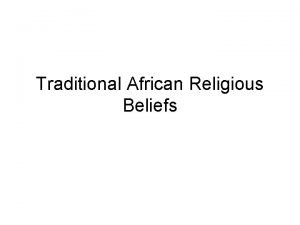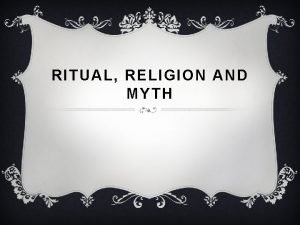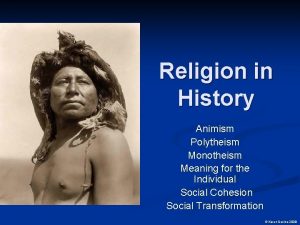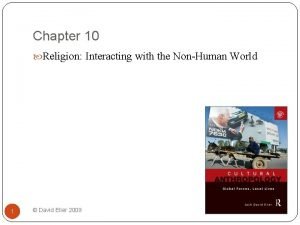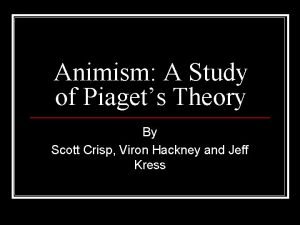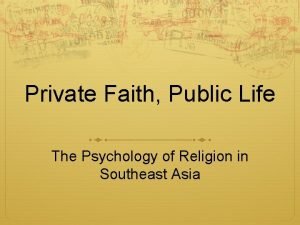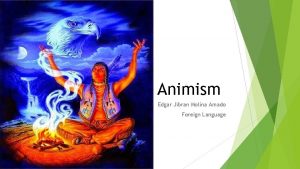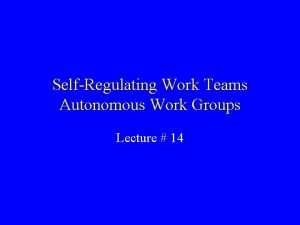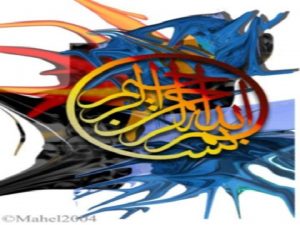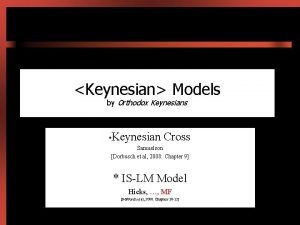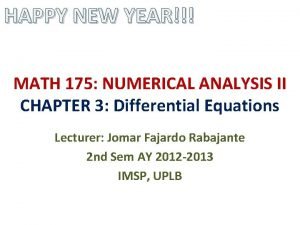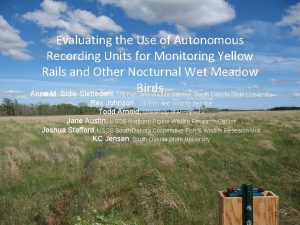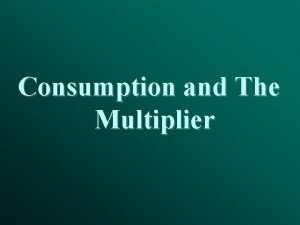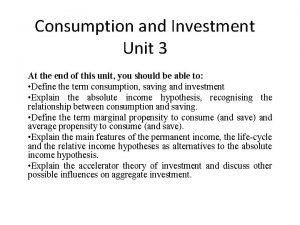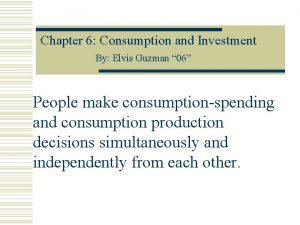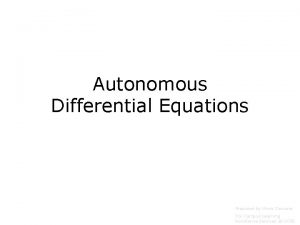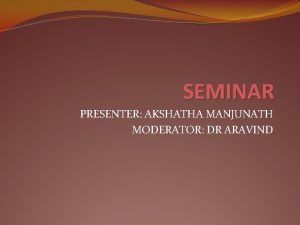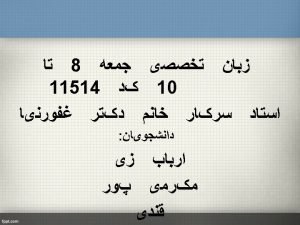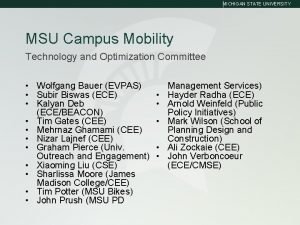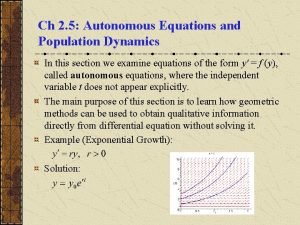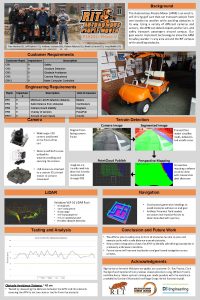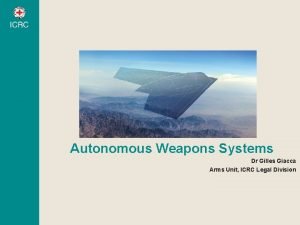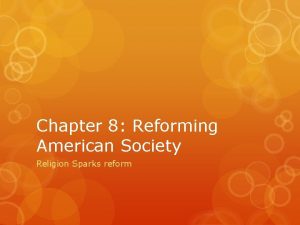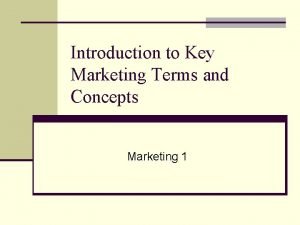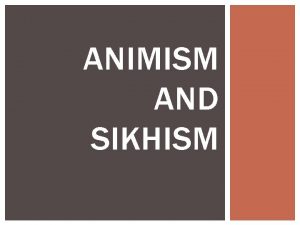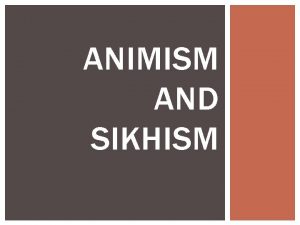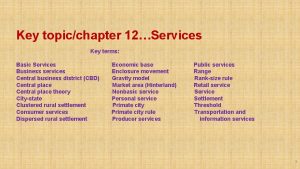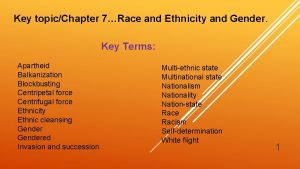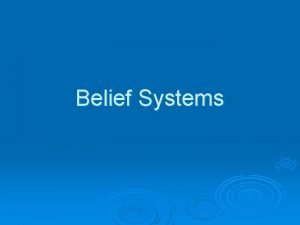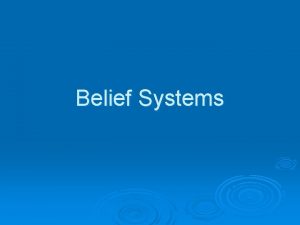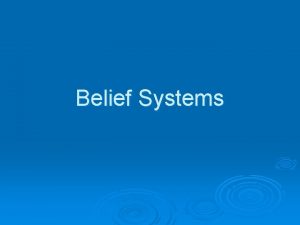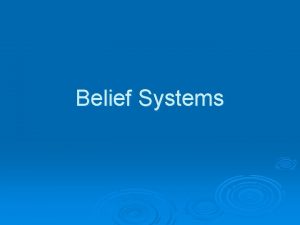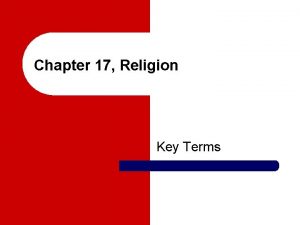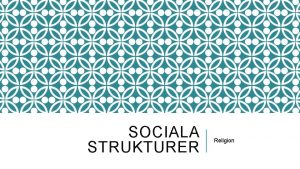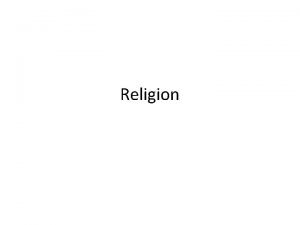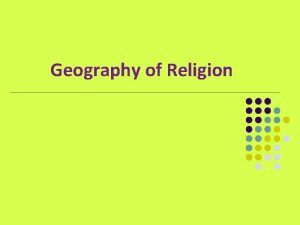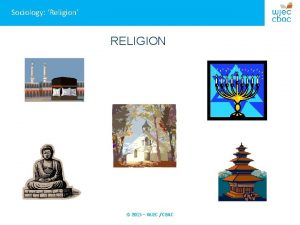Key topicchapter 6Religion Key Terms Animism Autonomous religion




























































- Slides: 60

Key topic/chapter 6…Religion Key Terms: Animism Autonomous religion Branch Cosmogony Denomination Diocese Ethnic religion Fundamentalism Ghetto Hierarchical religion Interfaith boundary Intrafaith boundary Monotheism Pilgrimage Polytheistic religion Religion Sect Secularism Shamanism Syncretism Traditional religion Tribal religion Universalizing religion Zionism 1

APHUG Chapter 6…Religion: a system of beliefs and practices that attempts to order life in terms of what the culture says you should do. This covers a wide range of things from dress code to what you can and can not eat. Religion takes many forms from worship of the souls of ancestors to the worship of spirits and God or many gods. Secularism: The idea that rules and moral laws should be about life on Earth not about following a religion. Religion doesn’t make the laws. This is a secular high school. Clearwater Catholic is not. Non-secular means heavily controlled by a religion. 2

Secular states RED States with Official State Religions Ambiguous or without data Grey 3

Samples of religious landscapes: 4

There a wide variety of religions in the world but most are classified into three categories: Monotheistic (one God), Polytheistic (more than one god), and Animistic which are ancient religions centered on the belief that inanimate objects such as mountains and trees possess spirits. Animistic religions are found among small groups worldwide, they are considered primitive religions and have little if any connection to each other. The four hearths for non-Animistic religions are: 1. The northern shores of the Mediterranean Sea; Where the ancient Greek religion began. 2. South Asia is the birthplace of Hinduism and Buddhism. 3. The Eastern Mediterranean gave rise to Judaism (which leads to Christianity and Islam). 4. Huang He River area in China is the hearth to several Chinese philosophies/religions. (Confucianism, Taoism) 5

Distribution of religions • Universalizing religions • Christianity, Islam, Buddhism. They try to bring in new members to the faith. • Ethnic religions • More than a statement of faith, its more of a culture and way of life. Members are usually born into the faith. Converts are not actively sought. (It’s kind of like a Folk culture) • Judaism, Hinduism, Shinto • Tribal or traditional religions • Animism, shamanism 6

How do Universalizing and Ethnic Religions Differ? Universalizing Ethnic • Appeal to people everywhere • Has meaning in particular place only. • Individual founder (prophet) • Unknown source. • Message diffused widely (missionaries) • Content focused on place and landscape of origin. • Followers distributed widely. • Followers highly clustered. • Holidays based on events in founder’s life. Christmas, Ramadan, Buddha Day • Holidays based on local climate and agricultural practice. Hanukah (Chanukah), various Autumn harvest festivals. 7

The Geography of Religion 8

• Sacred Structures – Temples / Pagodas – Churches / Basilicas – Mosques Religious Landscapes • Sacred Sites – mountains – rivers – Caves Sacred sites: Places with a “sense of place” for the religious group. Cities like Mecca, and Jerusalem, or places like Bear Butte to the Lakota Indians, or rivers like the Ganges to Hindus are all examples of sacred sites. 9

Commonalties of Holy Locations • Structure often dominates landscape with spirals, towers, or roofs • Center of city or village often used for gathering of community • Structure used as a reference point 10

WHAT IS THE PURPOSE OF A HOLY PLACE? • A place of worship and teaching. - Church • A space for prayer. - Mosques • Buildings to house relics and artifacts or entomb a leader. – Pagodas, Temples & Pyramids • A environmental astronomical calendar • A destination goal. - pilgrimage • Create an environment in the image of God or gods 11

Hinduism: is the oldest of today’s big religions and it ranks 4 th in size. The key belief is in Reincarnation. Your soul is forced to live through life after life in search of the true meaning of the world. The soul moves upward or downward according to the behavior of the person. You must pay for any evil you do (bad Karma) and can only go to heaven (Nirvana) when you are born to parents who are both priests (Brahmans) and live a life as a true priest. Hindu’s will not eat any animal that is a mammal. Chicken, fish are ok. Hindu’s believe in one God but that God can take many forms. Much like your view of this room is different from mine but we are in the same room. Shiva, Vishnu, and Brahma are the 3 main Avatar's (projected forms) of their God Hindu’s believe you are born into a class, (Caste) you must marry within your caste and you must stay in that caste throughout that life. The lowest caste are the Untouchables. The highest are the Brahmans. If you try to change your caste you will have to repeat it in your next life. What comes, comes for a reason and you must accept it. Hinduism is a religion of accepting your situation. Hinduism is not a strong religion outside of South Asia (India). As an Ethnic (nonuniversalizing) religion it doesn’t try to diffuse elsewhere. (Even though it doesn’t try to spread there are still 600 million Hindu’s) 12

Hinduism and the landscape Coastlines and river banks most sacred sites. 13

• 800 million + adherents primarily in China and S. E. Asia Buddhism • Originated near modern Nepal around 530 BC by prince Siddhartha Guatama. • Spread originally in India and Sri Lanka by Magadhan Empire (250 BC). • Indian traders brought it to China in 1 st century AD. • By 6 th century it had lost its hold on India, but was now in Korea and Japan. • Is a universalizing religion 14

Four Noble Truths: 1. All living beings must endure suffering. 2. Suffering, which is caused by desires (for things), leads to reincarnation. Greed causes pain. 3. The goal of existence is to escape from suffering and the endless cycle of reincarnation by means of Nirvana. 4. Nirvana is achieved by the Eightfold Path, which includes rightness of understanding, mindfulness, speech, action, livelihood, effort, thought, and concentration. Karma - your past bad or good actions determine your progress toward Nirvana through reincarnation. You are your own God. All the world’s suffering comes from greed. Give up greed and you will be happy and reach Nirvana. 15

Buddhist Landscapes Thailand Cambodia Tibet Buddhist Stupas 16

Tibetan Landscapes Tibetan Buddhist Prayer Wheels 17

ØJudaism: This religion is the first to teach the belief in one God. This religion comes from a nomadic tribe known as the Hebrews who lived in the Middle East over 4000 years ago. The 10 commandments, the Old Testament of the Bible and all the stories of Moses, Noah, etc. all come from this religion. ØThe key difference between Jews and Christians is that Christians accept Jesus as the savoir while the Jews are still waiting for God to send the savior. ØJudaism is not a universalizing religion and if found mostly in Israel, N. Europe and the US. ØThe God of Judaism is the same God for Christians and Muslims. 18

The Middle East is the hearth and Holy Land for 3 of the 5 biggest religions in the world; Judaism, Christianity and Islam. 19

Map of the Ottoman empire before WW 1. The Ottoman’s (TURKEY) owned almost all of the Middle East. 20

21

Jewish Landscapes Western Wall, Jerusalem Masada, Israel 22

Christianity • Over a billion adherents makes it the most practiced Religion in the world. • Originated in Bethlehem (8 -4 BC) and Jerusalem (AD 30) with Jesus Christ. • Spread by missionaries and the Roman Empire (Constantine A. D. 313). • It is the most practiced religion in Africa today. 23

ØChristianity: This religion has its origin in the Jewish faith. The key difference is the belief that Jesus is the savior and followers use the New Testament as the most important part of the Bible. Ø This is the world’s largest religion and is divided into 3 main branches with many denominations (parts which are well organized with a leadership organization, like the Methodists and Catholics) and sects , ( smaller churches which are on their own without an established organized leadership). Ø For the first 1000 years of Christianity there was only one branch (Catholic) with the Pope as the head of the church. Starting in 1054 the church began to split into different branches with the Eastern Orthodox splitting with the Catholics. Another split took place with Protestant churches (protesters) breaking away from the Catholics in the late 1400’s. ØChristianity is a universalizing religion and works hard to spread. 24

Distribution of Christianity • Largest religion (Over a billion) • Three major branches • Roman Catholic 50% • Protestant 25% • Eastern Orthodox 10% • Others: Pentecostal, Mormon, Armenian, Coptic, Maronites 25

Samples of the 3 key branches of the Christian Church. Each has several denominations: Catholic: Roman Catholic Church, Greek Catholic Church, Armenian Catholic Church Eastern Orthodox: Greek Orthodox Church, Russian Orthodox Church Protestant: Lutheran, Methodist, Baptist, Anglican, Presbyterian. Sects: (Small independent churches without an organized leadership) 1 st Church of God, Christ’s Sheppard Church, Mount Carmel Church. 26

Christianity and the landscape: • Church as center of the settlement • Collective worship important • Architecture, layout symbolic • Cemeteries as land use • Churches built to show the power and importance of the church in the community. Often towers over the area. 27

Vermont Paris Sacramento 28

Church of Resurrection Saint Petersburg, Russia St. Basil, Moscow, Russia 29

Saint Peters at the Vatican, Rome Italy 30

Islam: This religion is similar to the Jewish and Christian faith with the same God and much of the same teachings except for those added by the prophet Muhammad was born in Mecca in the late 500’s and raised in the many god belief of that time. As an adult the same God as the Christians and Jews, spoke to Muhammad and told him to begin teaching that there is no other God but God (Allah) and to spread the religion. No religion in history spread as far and as fast as Islam. Today it is the #2 religion in size and is the fastest growing religion in the world. The religion is named Islam. A follower is a Muslim. Key differences-Mohammad added numerous things to the Christian and Jewish beliefs: 1. Go to Mecca 2. Pray 5 times a day. 3. Fast during the holy month of Ramadan 4. Recite the Muslim prayer when you pray. 5. Give to the poor. He also added guidelines for the position and duties of men and women. Islam is a universalizing religion and is the fastest growing of them all. 31

Distribution of Islam: • Fastest growing religion (Over a billion) • Two major branches • Sunni 85% Any person can be a religious Imam (leader). • Shiite 15% Only a relative of Mohammed can be an Imam. • North Africa, SW Asia (the Middle East), Indonesia, and world wide. 32

Diffusion of Islam 33

Prophet: Muhammad Islam Holy Text: Koran Five Pillars of Islam Reading the Koran, Brunei Islamic Calendar • There is one God and Muhammad is his messenger. • Begins in AD 622 when Muhammad was commanded • Prayer five times daily, facing Mecca. to Mecca from Medina (Hijra). • The giving of alms(charity) to the poor. • Lunar calendar makes Ramadan move through the • Fasting during Ramadan for purification and seasons (30 year cycle - 19 submission. years with 354 days and 11 • If body and income allow, a Muslim must make a with 355). pilgrimage (hajj) to Mecca in his lifetime. 34

Prophet: Muhammad Islam Holy Text: Koran 35

The Muslim Landscape Forbidden by their religion to create any art work showing Mohammed, Muslims put great detail into their designs and decorations. Great giant arches and dome’s are important in their art and design. Great Mosque in Cordoba Spain 36

Sheikh Lotfallah Mosque, Isfahan, Iran 37

The Kabba in Mecca, Saudi Arabia 38

In the part of Jerusalem known as the Old City, three religions rub elbows: Islam’s sacred golden Dome of the Rock is 200 yards from the Christian Church of the Holy Sepulture (top left) and Judaism's holy Western Wall (Lower left). 39

Other large religions/philosophies: Not exactly religions but very important philosophic ways of thought and behavior. Taoism: One of the two big philosophies that began in ancient China. Taoism believes in the need to live in harmony with nature. Taoists believe in things being simple, spontaneous, tenderness, and tranquility. They believe that the best governments are the least governments. All living creatures have spirits to be worshiped. Taoists don’t have one single God. Confucianism: Confucianism is not a religion but is a way of live. It does not preach anything about a heaven, God, or Gods. Confucius taught that service to one’s fellow man was more important than service to any Gods. Study, hard work, dedication to the country, family, emperor and all mankind are the ideas of Confucianism. 40

Sikhism: The newest of all the large religions, Sikhism is a kind of combination of Hinduism, Buddhism and Islam. It believes in one supreme God and reincarnation and Karma. The basic human flaw of selfcenteredness can be overcome through proper reverence for God, commitment to hard work, service to humanity, and sharing the fruits of one's labor. Sikhs follow the teachings of 10 guru’s (teachers) who lived from the 1490 -1708. Sikhism has no formal priesthood. Private worship at home in the morning and evening is encouraged. Worship services at the temple consist of hymns and prayers, readings from the Holy Granth, sermons, and the sharing of a sort of communion rite at the end of worship and in dinners following the service. Sikhism can best be understood as a mainstream, monotheistic religion with a strong emphasis on ethical behavior, seeing itself as a religion that transcends sectarian traditions. Though found worldwide most followers live in the Indian state of Punjab. 41

v. The role of Religion in conflicts: Religious beliefs and histories can bitterly divide people and countries. Differences within the religion itself can lead to bitter warfare between members of the same religion. (Protestant and Catholic wars for the 1600’s) v Cult: A cult is a group that claims to be part of the religion, yet denies essential truth(s) of that religion. It’s different from the mainstream beliefs of that religion. v. Interfaith boundaries: Boundaries where two different religions meet. Pakistan (Muslim) and India (mostly Hindu) Greece (Eastern Orthodox Christian) and Turkey (Muslim) These areas often areas of conflict. For example: Israel and Palestine v. Intrafaith boundaries: Boundaries where two different groups within the same religion meet. Protestant and Catholic Christian areas. Sunni and Shiite Muslim areas. 42

Interfaith boundaries in Europe: Red-Eastern Orthodox Christian Green-Islam Blue-Catholic Christian Purple-Protestant Christians 43

Are these Interfaith or Intrafaith boundaries? 44

Sunni and Shia Muslims often do not get along well. 45

v. Religious fundamentalism and extremism: Every religion has its followers who go too far in their zeal to prove their religion is superior (racism? ? ? ) Fundamentalism believes that its religious beliefs are nonnegotiable and uncompromiseable. Extremism is fundamentalism carried to the point of violence. World Trade Center, Sept. 11, 2001 46

Mali: 6 young people get 100 lashes in Timbuktu: BAMAKO, Mali 11/29/12 (AP) — Timbuktu residents say that Islamist extremists controlling the city publicly whipped 6 young people, males and females aged between 16 to 22 years, who each received 100 lashes for having talked with each other on the city streets. Aboubacrine Yattara, who lives in Timbuktu and witnessed the whippings, told Associated Press over the phone that the young people were arrested last week by the Islamists controlling the city and were convicted Wednesday of co-mingling. (Hanging out together. ) He said they were flogged Thursday in Timbuktu's small market. The head of the Islamist brigade responsible for customs in Timbuktu, Mohamed Ag Mossa Intoulou, did not deny the whippings when contacted by AP but said he did not have authorization to speak to the press. 47

Iranian government (Non-secular) is afraid of Barbie has officially been pulled from Tehran's shelves, as Iran's religious leaders attempt to quash Western cultural influences. 48

Quiz yourself: 1. ______ boundaries are where two different religions meet. 2. _____ is a system of beliefs and practices that attempts to order life in terms of what the culture says you should do. 3. The 3 categories of religions are _____, ______, and ______ 4. In Hinduism and Buddhism _______ is your past bad or good actions which determine your progress toward Nirvana through reincarnation. 5. ______ religions try to bring in new members to the faith. Name 3. 6. ______ believes that its religious beliefs are nonnegotiable and uncompromiseable. 7. The religion is known as _______ and a follower is a Muslim. 8. _______ religion believes the all the world’s suffering comes from greed. 9. _______ is the fastest growing of all the religions. 10. This Christian church branch began in the 1054 split with the Catholic church. 11. _______ is the first to teach the belief in one God. 12. _______ are places with a “sense of place” for the religious group. 13. _______ is the belief that rules and moral laws should be about life on Earth not about following a religion. 14. In which type of religion (universalizing or ethnic) are followers highly clustered. 49

Quiz answers: 1. Interfaith 2. Religion 3. Monotheistic, Polytheistic, Animistic 4. Karma 5. Universalizing, Christianity, Islam, Buddhism 6. Fundamentalist 7. Islam 8. Buddhist 9. Muslim 10. Eastern Orthodox 11. Judaism 12. Sacred places 13. Secular 14. Ethnic 50

Key topic/Test Chapter 6: These questions come from a combination of our slides, your text book, and common knowledge you should have discussed in your AP classroom. 1) With respect to the relationship between culture, religion, and the physical environment… A) few religions derive meaningful events from the physical environment. B) religious ideas may be responsible for some of the changes people make in the physical environment C) religion is no longer an important source of identification for a distinct cultural group D) All of the above are true. 2) A large and fundamental division within a religion is a… A) branch. B) denomination. C) sect. D) dialect. 3) A relatively small group that has broken away from an established church is a…A) branch. B) denomination. C) sect. D) dialect. 4) A universalizing religion… A) is based on the physical characteristics of a particular location on Earth. B) appeals to people living in a wide variety of locations. C) is rarely transmitted through missionaries. D) is intentionally developed to be a world religion. 5) The world's largest universalizing religion is… A) Buddhism. B) Christianity. C) Hinduism. D) Islam. 6) The world's largest ethnic religion is… A) Confucianism. B) Daoism. C) Hinduism. D) Shintoism. 7) Christianity first diffused from its hearth through… A) contagious diffusion. B) hierarchical diffusion. C) relocation diffusion. D) All of the above were equally important. 8) Which is a branch of Christianity? A) Druze B) Eastern Orthodox C) Shiite D) Theravadist 9) Protestants in Ireland are… A) dispersed throughout the island. B) recent immigrants from Great Britain. C) highly clustered in one part of the island. D) highly integrated with the Roman Catholic population. 10) The goal of the majority of people living in Northern Ireland is to… A) remain part of the United Kingdom. B) migrate to the Republic of Ireland. C) become part of the Republic of Ireland. D) join the Irish Republican Army. 51

11) Roman Catholics are clustered in the U. S. southwest primarily because of migration of… A) Roman Catholics from Latin America. B) Roman Catholics from the northeast U. S. C) Roman Catholics from Ireland. D) Protestants to the north. 12) The people of Quebec are distinguished from residents of neighboring Canadian provinces and the United States because they… A) don't speak an Indo-European language. B) are not predominantly Christian. C) frequently use religious toponyms. D) want to become part of France again. 13) Which of the following is not a universalizing religion? A) Buddhism B) Christianity C) Islam D) Judaism 14) Eastern Orthodoxy is an example of a Christian… A) branch. B) denomination. C) religion. D) sect. 15) Lutheranism is an example of a Christian… A) branch. B) denomination. C) religion. D) sect. 16) Muslims are clustered in… A) Sub-Saharan Africa. B) the Middle East. C) Eastern Europe. D) East Asia. 17) The dominant branch of Islam is… A) Druze. B) Eastern Orthodoxy. C) Shiite. D) Sunni. 18) The dominant branch of Islam in Iran is… A) Druze. B) Eastern Orthodoxy. C) Shiite. D) Sunni. 19) Adherents of which religion controlled much of present-day Spain until 1492, but not since then? A) Buddhism B) Christianity C) Hinduism D) Islam 20) What is the holiest book in Hinduism? A) the Bible B) the Old Testament C) the Quran D) none of the above 21) Which of the following is currently the most important religion in the homeland of the man who founded it? A) Buddhism B) Christianity C) Hinduism D) Islam 22) Unlike other universalizing religions, Buddhism… A) remained concentrated in one region of the world. B) was not begun by an individual founder. C) was founded in China. D) worships more than one god. 23) Mahayanists, in contrast to Theravadists, emphasize Buddha's…A) life of self-help. B) compassion. C) renouncing of worldly goods. D) wisdom. 24) Hinduism's caste system… A) assigns everyone to a distinct class. B) decrees the pilgrimages which should be taken. C) is a substitute for the lack of a holy book. D) identifies a family's important deities. 25) Adherents of which religion are also likely to believe in other religions simultaneously? A) Buddhism B) Christianity C) Hinduism D) Islam 52

26) Animists believe that… A) people should complete God's creation of the Earth. B) inanimate objects and natural events have spirits. C) people should make complete use of the Earth's resources. D) natural disasters are preventable. 27) The agricultural calendar is relatively unimportant to which type of religions? A) animist B) ethnic C) pagan D) universalizing 28) Which is not an ethnic Asian religion? A) Buddhism B) Confucianism C) Shintoism D) Daoism 29) Especially important in Confucianism is to… A) perform public service. B) reflect on the mystical and magical aspects of life. C) respect forces of nature as divine. D) believe in one all-powerful God. 30) Especially important in Daoism is to… A) perform public service. B) reflect on the mystical and magical aspects of life. C) respect forces of nature as divine. D) believe in one all-powerful God. 31) The belief in the existence of only one god is… A) animism. B) cosmogony. C) monotheism. D) solstice. 32) Followers of which religious branch do not trace their origin to Abraham? A) Eastern Orthodox B) Mahayana C) Shiite D) Sunni 33) For most of the past 2, 000 years, most Jews have been… A) highly clustered in present-day Israel. B) dispersed around the world. C) concentrated in the United States. D) forced to live in ghettos. 34) The concept of a ghetto originally referred to the area of a city… A) inside the walls. B) inhabited by the lowest-income people. C) where Jews were forced to live. D) where most blacks lived. 35) Judaism is classified as an ethnic rather than a universalizing religion, primarily because… A) its main holidays relate to events in the life of its founder, Abraham. B) it uses a lunar calendar. C) its rituals derive from the agricultural cycle in Israel. D) it commemorates the Exodus from Egypt. 36) Beliefs concerning the origin of the universe are… A) animism. B) cosmogony. C) monotheism. D) solstice. 37) Which is not a characteristic of a hierarchical religion? A) It has a well-defined hierarchical structure. B) It encourages each congregation to be self-sufficient. C) It organizes territory into local administrative units. D) It fosters interaction among different congregations. 38) Which ethnic religion follows a lunar calendar? A) Hinduism B) Islam C) Judaism D) all of the above 39) A mosque differs from a church, because a mosque… A) is not a sanctified place. B) is not a place of worship. C) displays a variety of architectural styles. D) contains relics of the founder. 53

40) Worship in Hinduism is most likely to take place… A) in a holy shrine. B) as part of a pilgrimage. C) at home. D) in a pagoda. 41) Cremation is more important than burial in which religion? A) Buddhism B) Christianity 42) The United Nations partition plan divided Palestine into all but which of the following? C) Hinduism D) Islam A) British Mandate B) Arab state C) Jerusalem district D) Jewish state 43) The situation in Northern Ireland is the result of… A) counties in Northern Ireland voting to remain in the United Kingdom. B) Catholic protest against discrimination by Protestants. C) British colonial control which contributed to poor economic conditions. D) all of the above 44) Palestinians include all but which of the following? A) residents of refugee camps B) residents of territories occupied by Israel C) citizens of other states calling themselves Palestinians D) Jewish citizens of Israel 45) Jerusalem is a Holy City to all but which of these religions? A) Christianity B) Judaism C) Hinduism D) Islam The following questions are written at the high school level. You will find some questions from part one often rewritten here. This is all designed to help you transition to the college/AP style of written questions. 46. The world's largest universalizing religion is… A) Islam B) Buddhism. C) Christianity. D) Hinduism. 47. The world's largest ethnic religion is… A) Shintoism. B) Confucianism. C) Daoism. D) Hinduism. 48. Which of the following is not a universalizing religion? A) Buddhism B) Christianity C) Islam D) Judaism 54

49. Hinduism's caste system… A) assigns everyone to a distinct class. B) decrees the pilgrimages which should be taken. C) is a substitute for the lack of a holy book. D) identifies a family's important deities. 50. The belief in the existence of only one god is… A) animism. B) cosmogony. C) monotheism. D) solstice. 51. Cremation is more important than burial in which religion? A) Buddhism B) Christianity C) Hinduism D) Islam 52. The idea that rules and moral laws should be about life on Earth not about following a religion. A) taboo B) sect C) secular D) non-secular E) monotheist 53. Which of these is not one of the four hearths of the major religions? A) Hang He river area B) northern Mediterranean Sea area C) the eastern Mediterranean Sea area D) South Africa E) South Asia 54. Places which have a “sense of place” for a religion are known as…A) Monoliths B) Paraliths C) laberyths D) sacred places E) religious landscapes 55. Which two of these religions believe in the concept of reincarnation? A) Judaism and Hinduism B) Hinduism and Buddhism C) Christianity and Buddhism D) Catholics and Protestants E) Islam and Judaism 56. Judaism is classified as an ethnic rather than a universalizing religion, primarily because… A) its main holidays relate to events in the life of its founder, Abraham. B) it uses a lunar calendar. C) its rituals derive from the agricultural cycle in Israel. D) it commemorates the Exodus from Egypt. 57. Which is a branch of Christianity? A) Druze B) Eastern Orthodox C) Shiite D) Theravadists 58. Boundaries where two different religions meet… A) Interfaith B) Intrafaith C) non-secular D) secular E) sect 59. _____ believes that its religious beliefs are nonnegotiable and uncompromiseable. _____ is fundamentalism carried to the point of violence. A) secularism, non-secularism B) Hinduism, Buddhism C) extremism, fundamentalism D) fundamentalism, extremism E) ethnic, universalizing 60. The 3 categories of religions are _____, ______, and ______. A) Catholic, Protestant, Hindu C) Universalizing, Secular, Ethnic D) Animistic, Universalizing, Secular B) Monotheistic, Polytheist, Animistic 55



Answer Key: 1. B 14. A 27. D 40. C 53. D 2. A 15. B 28. A 41. C 54. D 3. C 16. B 29. A 42. A 55. B 4. B 17. D 30. B 43. D 56. C 5. B 18. C 31. C 44. D 57. B 6. C 19. D 32. B 45. C 58. A 7. C 20. D 33. B 46. C 59. D 8. B 21. D 34. C 47. D 60. B 9. C 22. A 35. C 48. D 10. A 23. B 36. B 49. A 11. A 24. A 37. B 50. C 12. C 25. A 38. C 51. C 13. D 26. B 39. A 52. C 58

FR #1: A. Sacred sites are places with a “sense of place” for the religious group. These places have a special significance to followers of the religion. An example of a sacred site would include Mecca, which is the birthplace of Mohammed. (You can have other examples, as long as they have a special significance to a religion. For example; the Wailing Wall or Dome of the Rock in Jerusalem or the Holy Ganges river in India. ( worth 10 points) B. A pilgrimage is a journey or search of moral or spiritual significance. Typically, it is a journey to a shrine or other location of importance to a person's beliefs. (10 points) C. You can take either side of the question but you had to explain your answer. If you said that DD doesn’t effect a pilgrimage, you would need to say that the trip is so important to the person that the distance matters little. If you said hat DD does effect the trip you would have to say that the distance lessens the chance of the person making the journey. (worth 10 points) FR #2: A. An interfaith boundary is a boundary where two different religions meet. An example would be Eastern Europe, where largely Christian Europe borders the largely Muslim Middle East. (15 points) B. Interfaith boundaries often are places of conflict because of the cultural and religious differences of the two religions who border each other. Disagreements occur easily regarding sacred sites, food taboos, holy days, and the religious fundamentalism of one or both groups. (15 points) 59

Calculating your grade on test #6: Add how many you got correct on the multiple choice part (60 possible) to how many points you scored on the FR portion (60 possible)… 120 total. The following scale will show the approximate score if this test were the real AP exam. Remember that this is an approximation. While 65 -74% is normally the range for a 3 on the test, it is not definite. Over the years I have seen scores as low as 60% be the low portion of a 3 score. Out of 120 possible points: 78 -89 is most likely a 3 90 -103 is most likely a 4 104 -120 is most likely a 5 Now lets move on to the next chapter/key topic…the study of Race and Ethnicity. 60
 Secneer
Secneer African religious beliefs
African religious beliefs Example of
Example of Is animism monotheistic or polytheistic
Is animism monotheistic or polytheistic Animism vs animatism
Animism vs animatism Animism piaget example
Animism piaget example Indonesia map religion
Indonesia map religion Animism
Animism Animism piaget
Animism piaget Middle childhood psychology
Middle childhood psychology Liberty or freedom
Liberty or freedom Like terms and unlike terms in polynomials
Like terms and unlike terms in polynomials Like terms
Like terms Autonomous stage of learning
Autonomous stage of learning Autonomous benthic explorer
Autonomous benthic explorer Autonomous work groups
Autonomous work groups Autonomous data harvesting
Autonomous data harvesting Atonic vs autonomous bladder
Atonic vs autonomous bladder Atonic vs autonomous bladder
Atonic vs autonomous bladder Equilibrium output
Equilibrium output Mengkonfigurasi router pada stub as
Mengkonfigurasi router pada stub as Lump sum tax
Lump sum tax New year equation
New year equation Non autonomous differential equation
Non autonomous differential equation Autonomous recording units
Autonomous recording units Autonomous consumption
Autonomous consumption Relative income hypothesis
Relative income hypothesis Algebric demand function
Algebric demand function Cisco ap 컨트롤러형 설정
Cisco ap 컨트롤러형 설정 Autonomous investment
Autonomous investment Autonomous ode definition
Autonomous ode definition Autonomous investment
Autonomous investment Induced vs autonomous expenditure
Induced vs autonomous expenditure Autonomous expenditure
Autonomous expenditure Automatic bladder vs autonomic bladder
Automatic bladder vs autonomic bladder Condom catheter
Condom catheter Autonomous car ppt
Autonomous car ppt Frc java
Frc java Cambridgeshire autonomous metro
Cambridgeshire autonomous metro Ftc autonomous code blocks
Ftc autonomous code blocks Spains largest city
Spains largest city Forecasting demand for autonomous vehicles
Forecasting demand for autonomous vehicles Autonomous strategy
Autonomous strategy Autonomous ship
Autonomous ship Msu autonomous bus
Msu autonomous bus Limb
Limb Federal state autonomous educational institution
Federal state autonomous educational institution Astratum
Astratum Autonomous equations and population dynamics
Autonomous equations and population dynamics Autonomous people mover
Autonomous people mover Autonomous buildings sustainability
Autonomous buildings sustainability Autonomous weapon
Autonomous weapon What theories
What theories Autonomous artinya
Autonomous artinya Chapter 8 section 1 guided reading religion sparks reform
Chapter 8 section 1 guided reading religion sparks reform Chapter 5 the minor parties
Chapter 5 the minor parties Key terms in post colonial theory
Key terms in post colonial theory Key marketing terms
Key marketing terms Dho chapter 11 nutrition and diets
Dho chapter 11 nutrition and diets Grandfather clause apush
Grandfather clause apush Reviewing key terms
Reviewing key terms

